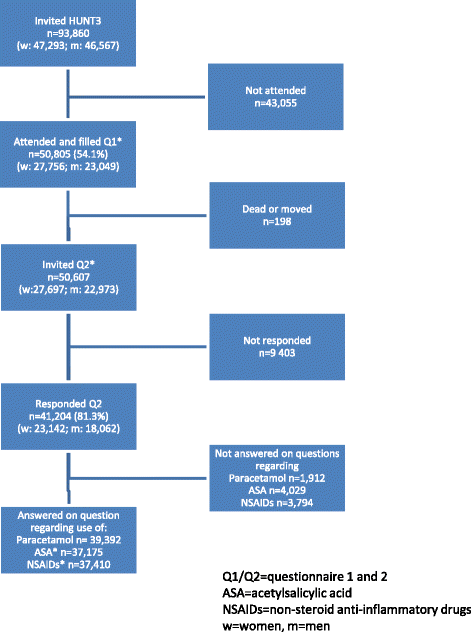Prevalence of use of non-prescription analgesics in the Norwegian HUNT3 population: Impact of gender, age, exercise and prescription of opioids
- PMID: 25934132
- PMCID: PMC4428499
- DOI: 10.1186/s12889-015-1774-6
Prevalence of use of non-prescription analgesics in the Norwegian HUNT3 population: Impact of gender, age, exercise and prescription of opioids
Abstract
Background: There are concerns about potential increasing use of over-the-counter (OTC) analgesics. The aims of this study were to examine 1) the prevalence of self-reported use of OTC analgesics; 2) the prevalence of combining prescription analgesics drugs with OTC analgesics and 3) whether lifestyle factors such as physical activity were associated with prevalence of daily OTC analgesic use.
Methods: Questionnaire data from the Nord-Trøndelag health study (HUNT3, 2006-08), which includes data from 40,000 adult respondents. The questionnaire included questions on use of OTC analgesics, socioeconomic conditions, health related behaviour, symptoms and diseases. Data were linked to individual data from the Norwegian Prescription Database. A logistic regression was used to investigate the association between different factors and daily use of paracetamol and/or non-steroid anti-inflammatory drugs (NSAIDs) in patients with and without chronic pain.
Results: The prevalence of using OTC analgesics at least once per week in the last month was 47%. Prevalence of paracetamol use was almost 40%, compared to 19% and 8% for NSAIDs and acetylsalicylic acid (ASA), respectively. While the use of NSAIDs decreased and the use of ASA increased with age, paracetamol consumption was unaffected by age. Overall more women used OTC analgesics. About 3-5% of subjects using OTC analgesics appeared to combine these with the same analgesic on prescription. Among subjects reporting chronic pain the prevalence of OTC analgesic use was almost twice as high as among subjects without chronic pain. Subjects with little physical activity had 1.5-4 times greater risk of daily use of OTC compared to physically active subjects.
Conclusions: Use of OTC analgesics is prevalent, related to chronic pain, female gender and physical inactivity.
Figures


References
-
- Pain Control. Using Nonprescription Analgesics [http://www.pharmacytimes.com/publications/otc/2013/otcguide-2013/Pain-Co...]
Publication types
MeSH terms
Substances
LinkOut - more resources
Full Text Sources
Other Literature Sources
Medical

